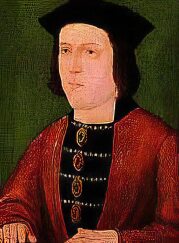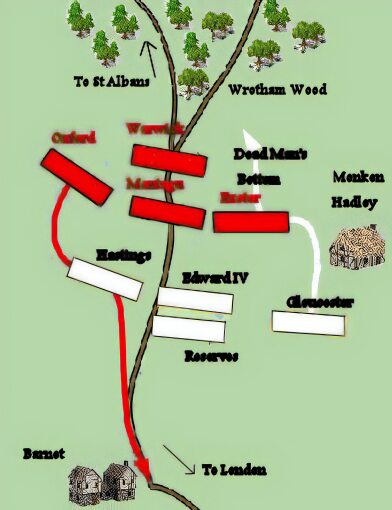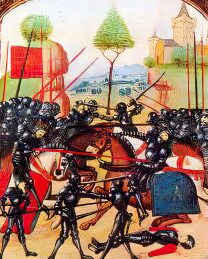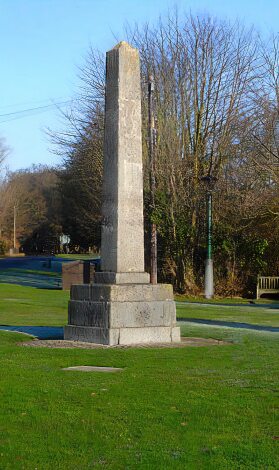14th April 1471
The Battle of Barnet was a decisive confrontation in the Wars of the Roses, between the rival Houses of Lancaster and York, along with the subsequent Battle of Tewkesbury, it secured the throne for the Yorkist King Edward IV.
Edward IV
Edward IV's proud and haughty first cousin, Richard Neville, Earl of Warwick, known as 'the Kingmaker provided help to enable him to mount England's throne. Warwick planned an advantageous marriage alliance for Edward to marry a French princess, Bona of Savoy. Edward, however, who became king at just nineteen years old, had other plans, he met and secretly married Elizabeth Woodville, the widow of Sir John Grey, a Lancastrian knight and daughter of Sir Richard Woodville (later Earl Rivers) and Jacquetta of Luxembourg. Much to Warwick's chagrin, at the new queen's request, the king bestowed gifts of land and titles on her despised relations and arranged marriages to rich and powerful families for the Woodvilles, regarded by many as upstarts.
Richard Neville, Earl of Warwick
The exasperated Warwick decided his only course of action was to replace the king by his younger brother, George, Duke of Clarence. He planned and instigated several rebellions in the north, to lure Edward from his power base in the south. Edward found himself outnumbered and while retreating, he discovered that Warwick and Clarence had called for open support of the rebellion.
Edward was taken prisoner at the Battle of Edgecote Moor on 26 July 1469 and taken to Warwick Castle, but eventually released, as most Yorkists refused to support Warwick. Warwick then plotted a further rebellion, but he and the Duke of Clarence were forced to flee to France after the Battle of Losecoat Field, on 12 March 1470.
In a subtle stroke of diplomacy, Louis XI of France, known as the Spider, reconciled the discontented Warwick with the Lancastrian queen, Margaret of Anjou, then in exile in France, no mean feat, since they were bitter enemies and Margaret had executed Warwick's father, Salisbury. Warwick is reported to have spent hours on his knees before Margaret before she would consent to the alliance. His younger daughter, Anne Neville, was betrothed to Margaret's son, Edward, the Lancastrian Prince of Wales.
Warwick invaded England on Margaret's behalf in 1470, resulting in the flight of Edward IV to Burgundy and the release of Henry VI from the Tower of London and his brief reinstatement as King. A sad and pitiful figure, he was paraded through the streets of London in a shabby blue gown by George Neville, Archbishop of York and set up as a puppet King, whom the ambitious Warwick ruled through. Edward IV, backed by the Duke of Burgundy, returned in 1471, landing at Ravenspur, he met Warwick's forces at Barnet. George of Clarence, Shakespeare's, 'false, fleeting, perjured Clarence', discontented to now find himself fighting to reinstate the Lancastrian dynasty, made secret attempts to reinstate himself in his brother Edward IV's favour. These being accepted, Clarence deserted his erstwhile ally Warwick and rejoined his brother's forces.
The Battle
Battle of Barnet
The armies of Edward and Warwick met for the final time at Barnet at a place called Gladmore Heath. There is a dispute as to where Gladmore Heath was situated, as the name has long since fallen out of use. It is generally thought that the battle took place in and around Hadley.
The Battle of Barnet
Warwick's army was already in position when Edward's army arrived on the evening of 13th April. King Edward positioned his troops in the dark, intending to repel an expected attack at dawn.The Yorkist king deployed Hastings on the left and his trusted youngest brother, Richard, Duke of Gloucester, aged eighteen at the time, to lead the right flank. while Clarence fought alongside Edward in the centre, presumably to keep a close eye on him. A contingent of reserves was kept at the rear. In the dark Edward IV misjudged the distance between his men and the enemy, and drew up much closer to Warwick than he had intended. It proved to be a fortunate error, for the Lancastrian artillery kept up a constant barrage during the night, but overshot their opponents almost entirely.
In the rival Lancastrian army, the left-wing was commanded by John de Vere, Earl of Oxford, the centre, which straddled the road, (now the modern A 1000), was commanded by Warwick, the Lancastrian right was headed by Henry Holland, Duke of Exeter. Warwick, together with his brother John Neville, Marquis Montagu retained overall command. All were dismounted, Warwick, usually a cautious warrior, had been persuaded by his brother to leave his horse were the obelisk at Hadley High Stone is now situated
The battle commenced early the following morning, a thick morning mist enveloped the battlefield and the two opposing armies were displaced laterally with each other. Neither group was facing the other; each was offset slightly to the right. The Lancastrian army attempted to exploit this advantage and the Earl of Oxford's wing quickly overwhelmed Hastings', panic ensued with the Yorkist soldiers fleeing towards Barnet, pursued by the Lancastrians. Some of Hasting's men continued to flee until they were safely within the walls of London, where they spread stories of the Yorkist's defeat. Oxford's contingent dispersed to loot their fallen enemies. The staunchly Lancastrian Oxford then succeeded in rallying some of his men and led them back to the battlefield. Due to the thick fog which had descended, visibility was poor and both armies were unaware of Oxford's victory over Hastings.
The Battle of Barnet monument
The Lancastrian left-wing had suffered a similar fate to that Oxford had inflicted on its counterpart; with Richard of Gloucester exploiting the misaligned forces and beating Exeter back, rotating the entire battle line. Warwick, observing the shift, ordered most of his reserves to Exeter's assistance, and brought the rest into fighting at the centre. Oxford returned to the battle to the rear of John Neville, Marquess Montagu, younger brother of the Earl of Warwick. Obscured by the mist, Oxford's "star with rays" banner was mistaken for Edward's "sun in splendour" banner by Montagu's soldiers, who unleashed a deadly volley of arrows at their comrades.
To cries of 'Treason!' Oxford and his soldiers retreated from the battle. The shouts of treason spread through the Lancastrian line, which broke and fled in panic and confusion. As the fog eventually began to lift, King Edward saw that the Lancastrian centre was in disarray and sent in his reserves, heralding its total collapse. Montagu himself met his end at the hands of a Yorkist or one of Oxford's men.
Witnessing the demise of his brother, Warwick fled. According to the official version of the battle, the mighty Warwick was killed fleeing the field in an attempt to reach his horse. Probably the most likely method of his despatch was a sword thrust into his throat, after forcing open his visor. A wound on the left side of his neck is depicted in an illustration in the Yorkist chronicle the Arrival. Edward IV's sister Margaret Duchess of Burgundy, who must have been well informed, in the course of writing to her mother-in-law a few days after the battle, states that the Earl of Warwick was captured at the end of the battle, and whilst in the course of being taken alive to Edward "some men recognised him and killed him".
The battle was over by mid-morning. Losses on both sides were heavy, although few names have been recorded. The Yorkist dead included Humphrey Bourchier, Lord Cromwell, another Humphrey Bourchier, the son of Lord Berners, William Denys, Lord Say and Sele and the son and heir of Walter Blount, Lord Mountjoy. Apart from Warwick and his brother little is recorded of the Lancastrian dead.
Aftermath
Warwick's body together with that of his brother, Montagu, was later taken to London and displayed at St. Paul's covered only with a loincloth, before being buried at Bisham Priory in Berkshire. Exeter had been stripped of his armour and left for dead on the battlefield, but was discovered alive but severely injured. He was taken to Westminster Abbey and on his recovery, he was imprisoned in the Tower of London where he remained for four years.
Oxford survived to fight another day, following his flight from the battle, he escaped to France, he was eventually captured in 1473 after conquering St Michael's Mount in Cornwall. Twelve years later he escaped from prison and joined Henry Tudor, commanding the Lancastrian army at the Battle of Bosworth in 1485.
The Battle of Losecoat Field PreviousNext The Battle of Tewkesbury
